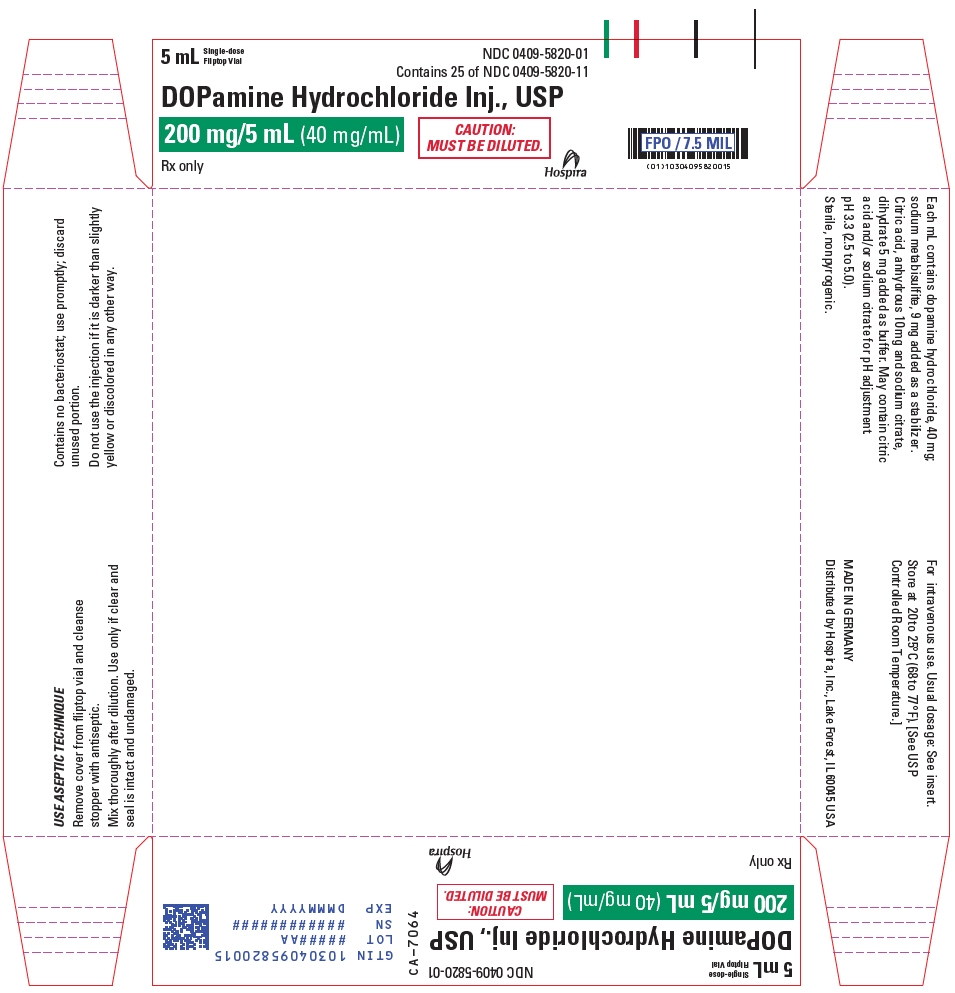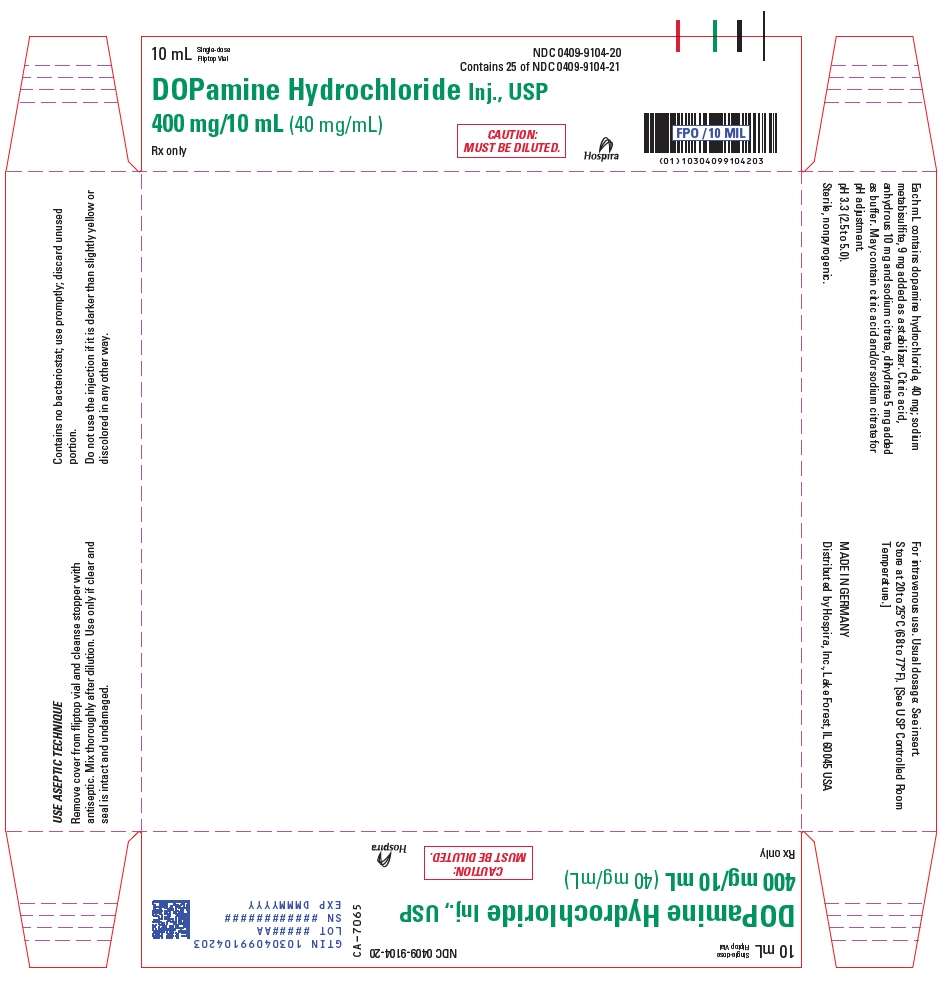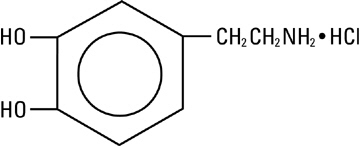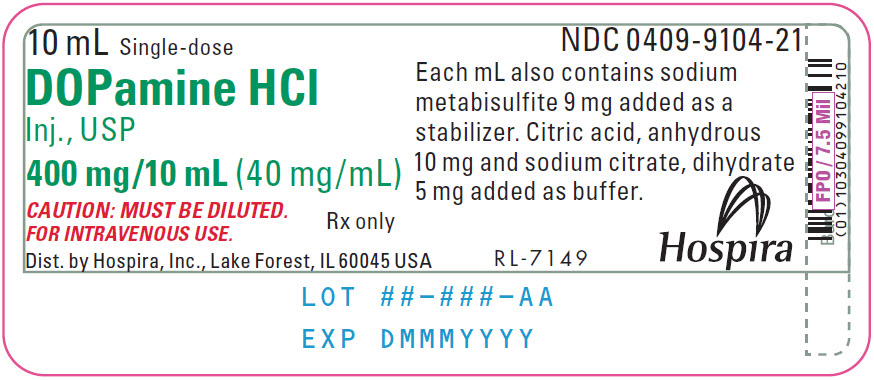DOPAMINE HYDROCHLORIDE injection, solution, concentrate
DOPamine Hydrochloride by
Drug Labeling and Warnings
DOPamine Hydrochloride by is a Prescription medication manufactured, distributed, or labeled by Hospira, Inc.. Drug facts, warnings, and ingredients follow.
Drug Details [pdf]
- SPL UNCLASSIFIED SECTION
-
DESCRIPTION
Dopamine, a sympathomimetic amine vasopressor, is the naturally occurring immediate precursor of norepinephrine. Dopamine hydrochloride is a white to off-white crystalline powder, which may have a slight odor of hydrochloric acid. It is freely soluble in water and soluble in alcohol. Dopamine HCl is sensitive to alkalies, iron salts, and oxidizing agents. Chemically it is designated as 4-(2-aminoethyl) pyrocatechol hydrochloride, and its molecular formula is C8H11NO2 HCl.
The structural formula is:
and the molecular weight is 189.64.
Dopamine hydrochloride injection is a clear, practically colorless, sterile, pyrogen-free, aqueous solution of dopamine HCl for intravenous infusion after dilution. Each milliliter of the 40 mg/mL preparation contains 40 mg of dopamine hydrochloride (equivalent to 32.31 mg of dopamine base). Each milliliter of preparation contains the following: Sodium metabisulfite 9 mg added as an antioxidant; citric acid, anhydrous 10 mg; and sodium citrate, dihydrate 5 mg added as a buffer. May contain additional citric acid and/or sodium citrate for pH adjustment. pH is 3.3 (2.5 to 5.0).
Dopamine must be diluted in an appropriate sterile parenteral solution before intravenous administration. (See DOSAGE AND ADMINISTRATION)
-
CLINICAL PHARMACOLOGY
Dopamine is a natural catecholamine formed by the decarboxylation of 3,4-dihydroxyphenylalanine (DOPA). It is a precursor to norepinephrine in noradrenergic nerves and is also a neurotransmitter in certain areas of the central nervous system, especially in the nigrostriatal tract, and in a few peripheral sympathetic nerves.
Dopamine produces positive chronotropic and inotropic effects on the myocardium, resulting in increased heart rate and cardiac contractility. This is accomplished directly by exerting an agonist action on beta-adrenoceptors and indirectly by causing release of norepinephrine from storage sites in sympathetic nerve endings.
Dopamine's onset of action occurs within five minutes of intravenous administration, and with dopamine's plasma half-life of about two minutes, the duration of action is less than ten minutes. However, if monoamine oxidase (MAO) inhibitors are present, the duration may increase to one hour. The drug is widely distributed in the body but does not cross the blood-brain barrier to a significant extent. Dopamine is metabolized in the liver, kidney, and plasma by MAO and catechol-O-methyltransferase to the inactive compounds homovanillic acid (HVA) and 3,4-dihydroxyphenylacetic acid. About 25% of the dose is taken up into specialized neurosecretory vesicles (the adrenergic nerve terminals), where it is hydroxylated to form norepinephrine. It has been reported that about 80% of the drug is excreted in the urine within 24 hours, primarily as HVA and its sulfate and glucuronide conjugates and as 3,4-dihydroxyphenylacetic acid. A very small portion is excreted unchanged.
The predominant effects of dopamine are dose-related, although it should be noted that actual response of an individual patient will largely depend on the clinical status of the patient at the time the drug is administered. At low rates of infusion (0.5 – 2 mcg/kg/min) dopamine causes vasodilation that is presumed to be due to a specific agonist action on dopamine receptors (distinct from alpha- and beta-adrenoceptors) in the renal, mesenteric, coronary, and intracerebral vascular beds. At these dopamine receptors, haloperidol is an antagonist. The vasodilation in these vascular beds is accompanied by increased glomerular filtration rate, renal blood flow, sodium excretion, and urine flow. Hypotension sometimes occurs. An increase in urinary output produced by dopamine is usually not associated with a decrease in osmolality of the urine.
At intermediate rates of infusion (2 – 10 mcg/kg/min) dopamine acts to stimulate the beta1-adrenoceptors, resulting in improved myocardial contractility, increased SA rate and enhanced impulse conduction in the heart. There is little, if any, stimulation of the beta2-adrenoceptors (peripheral vasodilation). Dopamine causes less increase in myocardial oxygen consumption than isoproterenol, and its use is not usually associated with a tachyarrhythmia. Clinical studies indicate that it usually increases systolic and pulse pressure with either no effect or a slight increase in diastolic pressure. Blood flow to the peripheral vascular beds may decrease while mesenteric flow increases due to increased cardiac output. Total peripheral resistance (alpha effects) at low and intermediate doses is usually unchanged.
At higher rates of infusion (10 – 20 mcg/kg/min) there is some effect on alpha-adrenoceptors, with consequent vasoconstrictor effects and a rise in blood pressure. The vasoconstrictor effects are first seen in the skeletal muscle vascular beds, but with increasing doses, they are also evident in the renal and mesenteric vessels. At very high rates of infusion (above 20 mcg/kg/min), stimulation of alpha-adrenoceptors predominates and vasoconstriction may compromise the circulation of the limbs and override the dopaminergic effects of dopamine, reversing renal dilation and naturesis.
-
INDICATIONS AND USAGE
Dopamine HCl is indicated for the correction of hemodynamic imbalances present in the shock syndrome due to myocardial infarction, trauma, endotoxic septicemia, open-heart surgery, renal failure, and chronic cardiac decompensation as in congestive failure.
Patients most likely to respond adequately to dopamine HCl are those in whom physiological parameters, such as urine flow, myocardial function, and blood pressure, have not undergone profound deterioration. Multiclinic trials indicate that the shorter the time interval between onset of signs and symptoms and initiation of therapy with blood volume correction and dopamine HCl, the better the prognosis. Where appropriate, blood volume restoration with a suitable plasma expander or whole blood should be accomplished prior to administration of dopamine HCl.
Poor Perfusion of Vital Organs – Urine flow appears to be one of the better diagnostic signs by which adequacy of vital organ perfusion can be monitored. Nevertheless, the physician should also observe the patient for signs of reversal of confusion or reversal of comatose condition. Loss of pallor, increase in toe temperature, and/or adequacy of nail bed capillary filling may also be used as indices of adequate dosage. Clinical studies have shown that when dopamine HCl is administered before urine flow has diminished to levels of approximately 0.3 mL/minute, prognosis is more favorable. Nevertheless, in a number of oliguric or anuric patients, administration of dopamine HCl has resulted in an increase in urine flow, which in some cases reached normal levels. Dopamine HCl may also increase urine flow in patients whose output is within normal limits and thus may be of value in reducing the degree of pre-existing fluid accumulation. It should be noted that at doses above those optimal for the individual patient, urine flow may decrease, necessitating reduction of dosage.
Low Cardiac Output – Increased cardiac output is related to dopamine's direct inotropic effect on the myocardium. Increased cardiac output at low or moderate doses appears to be related to a favorable prognosis. Increase in cardiac output has been associated with either static or decreased systemic vascular resistance (SVR). Static or decreased SVR associated with low or moderate movements in cardiac output is believed to be a reflection of differential effects on specific vascular beds with increased resistance in peripheral beds (e.g., femoral) and concomitant decreases in mesenteric and renal vascular beds.
Redistribution of blood flow parallels these changes so that an increase in cardiac output is accompanied by an increase in mesenteric and renal blood flow. In many instances the renal fraction of the total cardiac output has been found to increase. Increase in cardiac output produced by dopamine is not associated with substantial decreases in systemic vascular resistance as may occur with isoproterenol.
Hypotension – Hypotension due to inadequate cardiac output can be managed by administration of low to moderate doses of dopamine HCl which have little effect on SVR. At high therapeutic doses, dopamine's alpha-adrenergic activity becomes more prominent and thus may correct hypotension due to diminished SVR. As in the case of other circulatory decompensation states, prognosis is better in patients whose blood pressure and urine flow have not undergone profound deterioration. Therefore, it is suggested that the physician administer dopamine HCl as soon as a definite trend toward decreased systolic and diastolic pressure becomes evident.
- CONTRAINDICATIONS
-
WARNINGS
Contains sodium metabisulfite, a sulfite that may cause allergic-type reactions including anaphylactic symptoms and life-threatening or less severe asthmatic episodes in certain susceptible people. The overall prevalence of sulfite sensitivity in the general population is unknown and probably low. Sulfite sensitivity is seen more frequently in asthmatic than in nonasthmatic people.
Do NOT add dopamine HCl to any alkaline diluent solution since the drug is inactivated in alkaline solution.
Patients who have been receiving MAO inhibitors prior to the administration of dopamine HCl will require substantially reduced dosage. See Drug Interactions below.
-
PRECAUTIONS
General
- 1. Monitoring – Careful monitoring of the following indices is necessary during dopamine HCl infusion, as with any adrenergic agent: blood pressure, urine flow, and, when possible, cardiac output and pulmonary wedge pressure.
- 2. Hypovolemia – Prior to treatment with dopamine HCl, hypovolemia should be fully corrected, if possible, with either whole blood or plasma as indicated. Monitoring of central venous pressure or left ventricular filling pressure may be helpful in detecting and treating hypovolemia.
- 3. Hypoxia, Hypercapnia, Acidosis – These conditions, which may also reduce the effectiveness and/or increase the incidence of adverse effects of dopamine, must be identified and corrected prior to, or concurrently with, administration of dopamine HCl.
- 4. Decreased Pulse Pressure – If a disproportionate increase in diastolic blood pressure and a marked decrease in pulse pressure are observed in patients receiving dopamine HCl, the rate of infusion should be decreased and the patient observed carefully for further evidence of predominant vasoconstrictor activity, unless such effect is desired.
- 5. Ventricular Arrhythmias – If an increased number of ectopic beats are observed, the dose should be reduced if possible.
- 6. Hypotension – At lower infusion rates, if hypotension occurs, the infusion rate should be rapidly increased until adequate blood pressure is obtained. If hypotension persists, dopamine HCl should be discontinued and a more potent vasoconstrictor agent such as norepinephrine should be administered.
- 7. Extravasation – Dopamine HCl should be infused into a large vein whenever possible to prevent the possibility of extravasation into tissue adjacent to the infusion site. Extravasation may cause necrosis and sloughing of surrounding tissue. Large veins of the antecubital fossa are preferred to veins in the dorsum of the hand or ankle. Less suitable infusion sites should be used only if the patient's condition requires immediate attention. The physician should switch to more suitable sites as rapidly as possible. The infusion site should be continuously monitored for free flow.
- 8.
Occlusive Vascular Disease – Patients with a history of occlusive vascular disease (for example, atherosclerosis, arterial embolism, Raynaud's disease, cold injury, diabetic endarteritis, and Buerger's disease) should be closely monitored for any changes in color or temperature of the skin in the extremities. If a change in skin color or temperature occurs and is thought to be the result of compromised circulation in the extremities, the benefits of continued dopamine HCl infusion should be weighed against the risk of possible necrosis. This condition may be reversed by either decreasing the rate or discontinuing the infusion.
- IMPORTANT
- Antidote for Peripheral Ischemia: To prevent sloughing and necrosis in ischemic areas, the area should be infiltrated as soon as possible with 10 to 15 mL of saline solution containing from 5 to 10 mg of phentolamine mesylate, an adrenergic blocking agent. A syringe with a fine hypodermic needle should be used, and the solution liberally infiltrated throughout the ischemic area. Sympathetic blockade with phentolamine causes immediate and conspicuous local hyperemic changes if the area is infiltrated within 12 hours. Therefore, phentolamine should be given as soon as possible after the extravasation is noted.
- 9. Weaning – When discontinuing the infusion, it may be necessary to gradually decrease the dose of dopamine HCl while expanding blood volume with intravenous fluids, since sudden cessation may result in marked hypotension.
Drug Interactions
- 1. Because dopamine is metabolized by monoamine oxidase (MAO), inhibition of this enzyme prolongs and potentiates the effect of dopamine. Patients who have been treated with MAO inhibitors within two to three weeks prior to the administration of dopamine HCl should receive initial doses of dopamine HCl no greater than one-tenth (1/10) of the usual dose.
- 2. Concurrent administration of dopamine HCl and diuretic agents may produce an additive or potentiating effect on urine flow.
- 3. Tricyclic antidepressants may potentiate the pressor response to adrenergic agents.
- 4. Cardiac effects of dopamine are antagonized by beta-adrenergic blocking agents, such as propranolol and metoprolol. The peripheral vasoconstriction caused by high doses of dopamine HCl is antagonized by alpha-adrenergic blocking agents. Dopamine-induced renal and mesenteric vasodilation is not antagonized by either alpha- or beta-adrenergic blocking agents.
- 5. Haloperidol appears to have strong central antidopaminergic properties. Haloperidol and haloperidol-like drugs suppress the dopaminergic renal and mesenteric vasodilation induced at low rates of dopamine infusion.
- 6. Cyclopropane or halogenated hydrocarbon anesthetics increase cardiac autonomic irritability and may sensitize the myocardium to the action of certain intravenously administered catecholamines, such as dopamine. This interaction appears to be related both to pressor activity and to beta-adrenergic stimulating properties of these catecholamines and may produce ventricular arrhythmias and hypertension. Therefore, EXTREME CAUTION should be exercised when administering dopamine HCl to patients receiving cyclopropane or halogenated hydrocarbon anesthetics. It has been reported that results of studies in animals indicate that dopamine-induced ventricular arrhythmias during anesthesia can be reversed by propranolol.
- 7. The concomitant use of vasopressors and some oxytocic drugs may result in severe persistent hypertension. See Labor and Delivery below.
- 8. Administration of phenytoin to patients receiving dopamine HCl has been reported to lead to hypotension and bradycardia. It is suggested that in patients receiving dopamine HCl, alternatives to phenytoin should be used if anticonvulsant therapy is needed.
Pregnancy: Teratogenic Effects: Animal studies have revealed no evidence of teratogenic effects due to dopamine. However, in one study, administration of dopamine HCl to pregnant rats resulted in a decreased survival rate of the newborn and a potential for cataract formation in the survivors. There are no adequate and well-controlled studies in pregnant women and it is not known if dopamine crosses the placental barrier. Because animal reproduction studies are not always predictive of human response, this drug should be used during pregnancy only if, in the judgment of the physician, the potential benefit justifies the potential risk to the fetus.
Labor and Delivery
In obstetrics, if vasopressor drugs are used to correct hypotension or are added to a local anesthetic solution, some oxytocic drugs may cause severe persistent hypertension and may even cause rupture of a cerebral blood vessel to occur during the postpartum period.
-
ADVERSE REACTIONS
The following adverse reactions have been observed, but there are not enough data to support an estimate of their frequency.
Cardiovascular System:
ventricular arrhythmia
atrial fibrillation
ectopic beats
tachycardia
anginal pain
palpitation
cardiac conduction abnormalities
widened QRS complex
bradycardia
hypotension
hypertension
vasoconstrictionRespiratory System:
dyspnea
Gastrointestinal System:
nausea
vomitingMetabolic/Nutritional System:
azotemia
Central Nervous System:
headache
anxietyDermatological System:
piloerection
Other:
Gangrene of the extremities has occurred when high doses were administered for prolonged periods or in patients with occlusive vascular disease receiving low doses of dopamine HCl.
-
OVERDOSAGE
In the case of accidental overdosage, as evidenced by excessive elevation of blood pressure, reduce rate of administration or temporarily discontinue dopamine HCl until patient's condition stabilizes. Since dopamine's duration of action is quite short, no additional remedial measures are usually necessary. If these measures fail to stabilize the patient's condition, use of the short-acting alpha-adrenergic blocking agent phentolamine should be considered.
-
DOSAGE AND ADMINISTRATION
WARNING: This is a potent drug; it must be diluted before administration to the patient.
Dopamine Hydrochloride Injection, USP is administered (only after dilution) by intravenous infusion.
Suggested Dilution – For the 40 mg/mL preparation, transfer by aseptic technique the contents containing either 5 mL, 200 mg or 10 mL, 400 mg of Dopamine Hydrochloride to either a 250 mL or 500 mL bottle of one of the sterile intravenous solutions listed below:
0.9% Sodium Chloride Injection, USP
5% Dextrose Injection, USP
5% Dextrose and 0.9% Sodium Chloride Injection, USP
5% Dextrose and 0.45% Sodium Chloride Injection, USP
5% Dextrose and Lactated Ringer's Injection
Sodium Lactate Injection, USP 1/6 Molar
Lactated Ringer's Injection, USPThe resultant dilutions are summarized in the following chart:
Concentration of Dopamine Hydrochloride 40 mg/mL Volume of Dopamine Hydrochloride Injection, USP 5 mL 10 mL 250 mL Bottle of I.V. Solution 800 mcg/mL 1600 mcg/mL 500 mL Bottle of I.V. Solution 400 mcg/mL 800 mcg/mL 1000 mL Bottle of I.V. Solution 200 mcg/mL 400 mcg/mL Dopamine Hydrochloride Injection, USP has been found to be stable for a minimum of 24 hours after dilution in the foregoing intravenous solutions. However, as with all intravenous admixtures, dilution should be made just prior to administration.
Do NOT add Dopamine Hydrochloride to Sodium Bicarbonate Injection, USP or other alkaline intravenous solutions, since the drug is inactivated in alkaline solution.
Rate of Administration – Dopamine Hydrochloride Injection, USP after dilution, is administered intravenously by infusion via a suitable intravenous catheter or needle. When administering Dopamine Hydrochloride (or any potent medication) by continuous intravenous infusion, it is advisable to use a precision volume control intravenous set. Each patient must be individually titrated to the desired hemodynamic or renal response to dopamine.
In titrating to the desired increase in systolic blood pressure, the optimum dosage rate for renal response may be exceeded, thus necessitating a reduction in rate after the hemodynamic condition is stabilized.
Administration at rates greater than 50 mcg/kg/min have safely been used in advanced circulatory decompensation states. If unnecessary fluid expansion is of concern, adjustment of drug concentration may be preferred over increasing the flow rate of a less concentrated dilution.
Suggested Regimen:
- 1. When appropriate, increase blood volume with whole blood or plasma until central venous pressure is 10 to 15 cm H2O or pulmonary wedge pressure is 14 to 18 mm Hg.
- 2.
Begin infusion of diluted solution at doses of 2 – 5 mcg/kg/min of Dopamine Hydrochloride in patients who are likely to respond to modest increments of heart force and renal perfusion.
In more seriously ill patients, begin infusion of diluted solution at doses of 5 mcg/kg/min of Dopamine Hydrochloride and increase gradually using 5 to 10 mcg/kg/min increments up to a rate of 20 to 50 mcg/kg/min as needed. If doses in excess of 50 mcg/kg/min are required, it is advisable to check urine output frequently. Should urinary flow begin to decrease in the absence of hypotension, reduction of dopamine dosage should be considered. Multiclinic trials have shown that more than 50 percent of patients have been satisfactorily maintained on doses less than 20 mcg/kg/min.
In patients who do not respond to these doses with adequate arterial pressures or urine flow, additional increments of dopamine may be given in an effort to produce an appropriate arterial pressure and central perfusion. - 3.
Treatment of all patients requires constant evaluation of therapy in terms of blood volume, augmentation of cardiac contractility, and distribution of peripheral perfusion.
Dosage of dopamine should be adjusted according to the patient's response, with particular attention to diminution of established urine flow rate, increasing tachycardia or development of new dysrhythmias as indices for decreasing or temporarily suspending the dosage. - 4.
As with all potent intravenously administered drugs, care should be taken to control the rate of administration to avoid inadvertent administration of a bolus of the drug.
Parenteral drug products should be inspected visually for particulate matter and discoloration prior to administration, whenever solution and container permit.
-
HOW SUPPLIED
Dopamine Hydrochloride Injection, USP is supplied as follows (40 mg/mL):
Unit of Sale Total Strength/Total Volume
(Concentration)NDC: 0409-5820-01
25 Fliptop Vials in a Tray200 mg/5 mL
(40 mg/mL)NDC: 0409-9104-20
25 Fliptop Vials in a Tray400 mg/10 mL
(40 mg/mL)Avoid contact with alkalies (including sodium bicarbonate), oxidizing agents or iron salts.
Do not use the injection if it is darker than slightly yellow or discolored in any other way.
Store at 20 to 25°C (68 to 77°F). [See USP Controlled Room Temperature.]
Distributed by Hospira, Inc., Lake Forest, IL 60045 USA

LAB-1154-3.0
Revised: 02/2019
- PRINCIPAL DISPLAY PANEL - 5 mL Vial Label
-
PRINCIPAL DISPLAY PANEL - 5 mL Vial Tray
5 mL
Single-dose
Fliptop Vial
NDC: 0409-5820-01
Contains 25 of NDC: 0409-5820-11DOPamine Hydrochloride Inj., USP
200 mg/5 mL (40 mg/mL)
CAUTION:
MUST BE DILUTED.Rx only
Hospira

- PRINCIPAL DISPLAY PANEL - 10 mL Vial Label
-
PRINCIPAL DISPLAY PANEL - 10 mL Vial Tray
10 mL
Single-dose
Fliptop Vial
NDC: 0409-9104-20
Contains 25 of NDC: 0409-9104-21DOPamine Hydrochloride Inj., USP
400 mg/10 mL (40 mg/mL)
CAUTION:
MUST BE DILUTED.Rx only
Hospira

-
INGREDIENTS AND APPEARANCE
DOPAMINE HYDROCHLORIDE
dopamine hydrochloride injection, solution, concentrateProduct Information Product Type HUMAN PRESCRIPTION DRUG Item Code (Source) NDC: 0409-5820 Route of Administration INTRAVENOUS Active Ingredient/Active Moiety Ingredient Name Basis of Strength Strength DOPAMINE HYDROCHLORIDE (UNII: 7L3E358N9L) (DOPAMINE - UNII:VTD58H1Z2X) DOPAMINE HYDROCHLORIDE 40 mg in 1 mL Inactive Ingredients Ingredient Name Strength SODIUM METABISULFITE (UNII: 4VON5FNS3C) 9 mg in 1 mL ANHYDROUS CITRIC ACID (UNII: XF417D3PSL) 10 mg in 1 mL TRISODIUM CITRATE DIHYDRATE (UNII: B22547B95K) 5 mg in 1 mL Packaging # Item Code Package Description Marketing Start Date Marketing End Date 1 NDC: 0409-5820-01 25 in 1 TRAY 08/25/2005 1 NDC: 0409-5820-11 5 mL in 1 VIAL, SINGLE-DOSE; Type 0: Not a Combination Product Marketing Information Marketing Category Application Number or Monograph Citation Marketing Start Date Marketing End Date NDA NDA018132 08/25/2005 DOPAMINE HYDROCHLORIDE
dopamine hydrochloride injection, solution, concentrateProduct Information Product Type HUMAN PRESCRIPTION DRUG Item Code (Source) NDC: 0409-9104 Route of Administration INTRAVENOUS Active Ingredient/Active Moiety Ingredient Name Basis of Strength Strength DOPAMINE HYDROCHLORIDE (UNII: 7L3E358N9L) (DOPAMINE - UNII:VTD58H1Z2X) DOPAMINE HYDROCHLORIDE 40 mg in 1 mL Inactive Ingredients Ingredient Name Strength SODIUM METABISULFITE (UNII: 4VON5FNS3C) 9 mg in 1 mL ANHYDROUS CITRIC ACID (UNII: XF417D3PSL) 10 mg in 1 mL TRISODIUM CITRATE DIHYDRATE (UNII: B22547B95K) 5 mg in 1 mL Packaging # Item Code Package Description Marketing Start Date Marketing End Date 1 NDC: 0409-9104-20 25 in 1 TRAY 06/30/2005 1 NDC: 0409-9104-21 10 mL in 1 VIAL, SINGLE-DOSE; Type 0: Not a Combination Product Marketing Information Marketing Category Application Number or Monograph Citation Marketing Start Date Marketing End Date NDA NDA018132 06/30/2005 Labeler - Hospira, Inc. (141588017) Establishment Name Address ID/FEI Business Operations Hospira, Inc. 093132819 ANALYSIS(0409-5820, 0409-9104) , LABEL(0409-5820, 0409-9104) , MANUFACTURE(0409-5820, 0409-9104) , PACK(0409-5820, 0409-9104) Establishment Name Address ID/FEI Business Operations Hospira, Inc. 827731089 ANALYSIS(0409-5820, 0409-9104)
© 2026 FDA.report
This site is not affiliated with or endorsed by the FDA.


